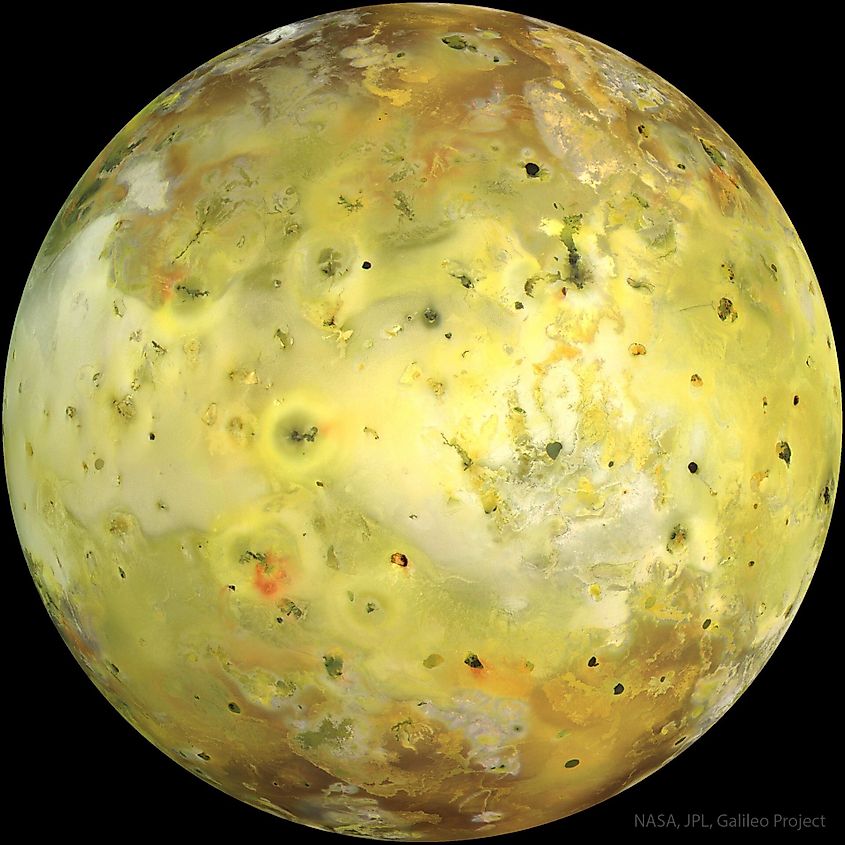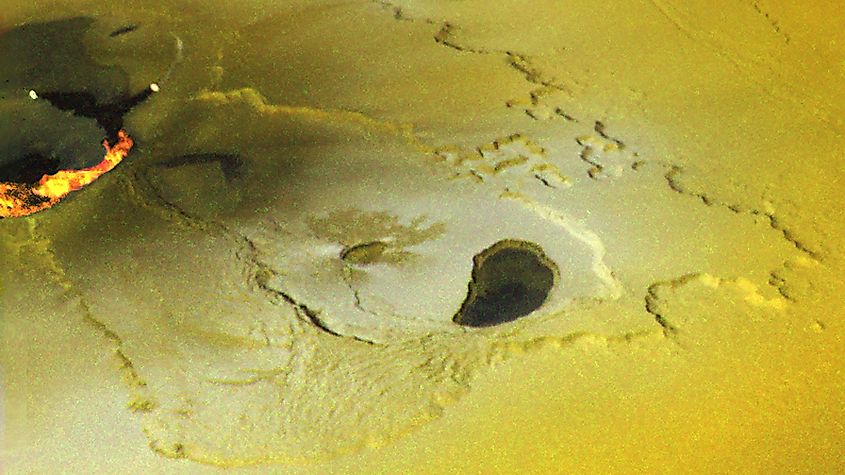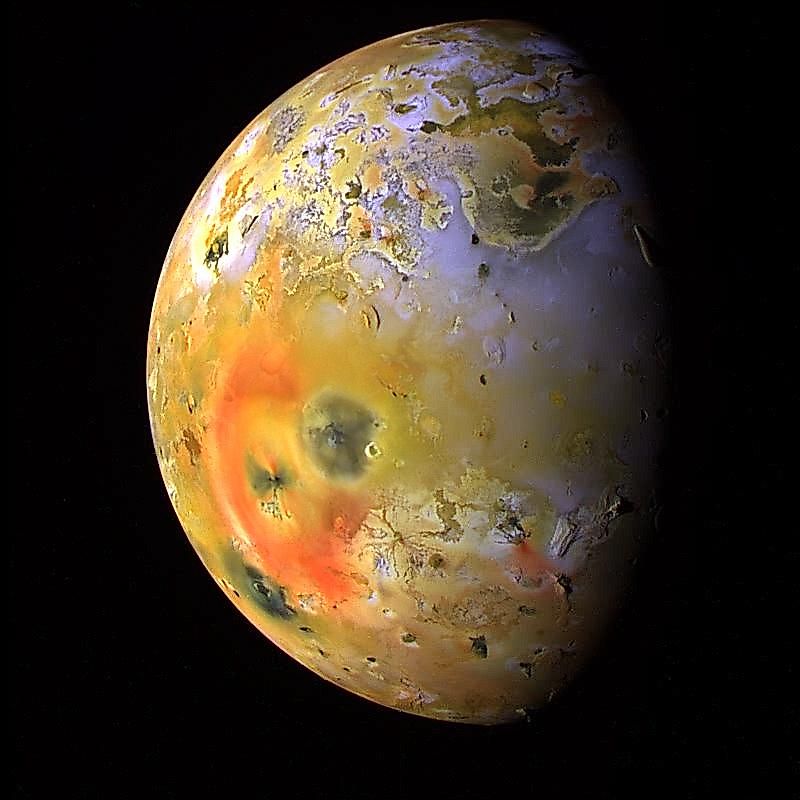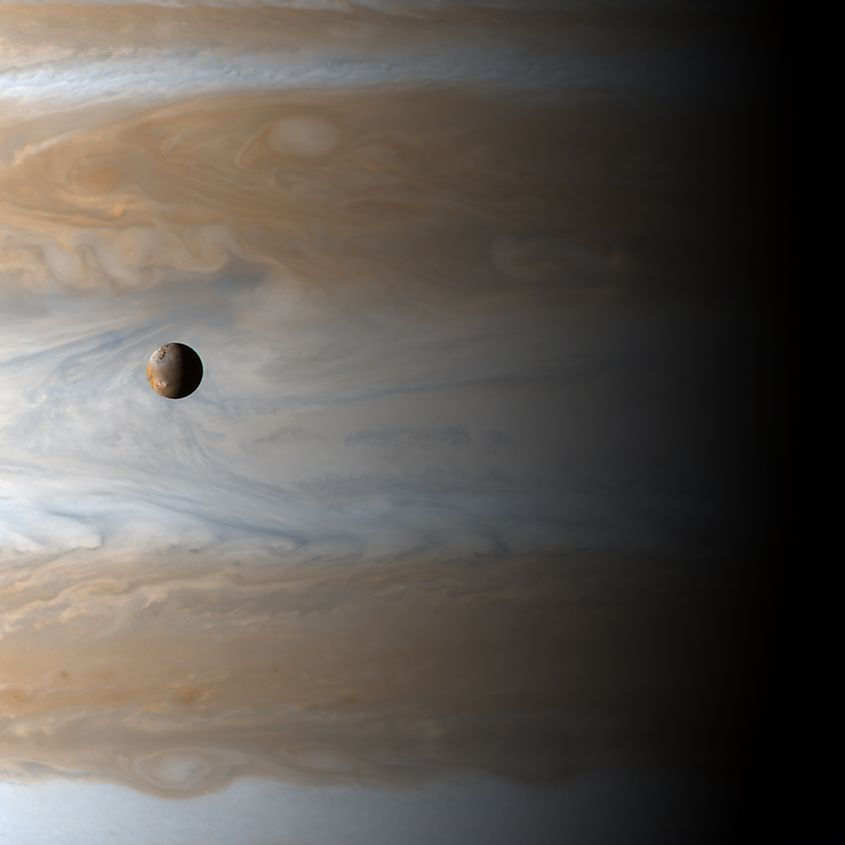
Io: The Volcanic Moon of Jupiter
Our solar system is home to over 200 individual moons. Among these worlds, there is more diversity than there is among the planets themselves. While we generally think of moons as being grey, dull, cratered worlds, this is far from being accurate. While most moons look similar to Earth’s moon, many others are perhaps more interesting than the planets they orbit. A perfect example of this is Jupiter’s moon, Io. Io is the innermost of Jupiter’s four Galilean moons and was first discovered by Galileo Galilei in 1610.
A Colorful Moon

At first glance, the most obvious feature of Io is the vast array of different colors across its surface. These colors are due to Io’s composition, which is significantly different from most moons in the outer solar system. Among the moons of the outer solar system, the vast majority are composed almost entirely of rock and ice. Io is primarily composed of silicate rock and iron, which makes its composition more similar to the rocky planets than other moons. The surface of Io is covered in sulfur-based compounds, and it is these compounds that give Io its various colors. In fact, the various colors are due to temperature changes that alter the color of sulfur-based compounds.
Geology of Io

Before any spacecraft visited the outer planets, astronomers had largely assumed that the moons of the gas giants would be cold, dry, barren worlds, with the idea of any of them being geologically active almost unthinkable. As is the case with much of science, the expectations of humans are largely thrown aside by the reality of nature. When Voyager 1 took the first up-close images of Io, astronomers were stunned to see a moon that looked so much different from anything they had expected. Not only was Io colorful, but its surface also lacked any large impact craters. This was rather atypical of a moon, as most lack any geologic activity that would otherwise destroy and erode craters. In fact, this is why Earth has such a low number of impact craters on its surface, as geologic activity quickly erases them from the surface. The presence of a large number of craters is evidence that a world has not experienced any geologic change in billions of years, hence the reason why Earth’s moon has so many craters. The fact that Io had little to no craters suggested that the moon is geologically active, something that had been unheard of until the Voyager 1 mission. Further images of Io from the Voyager spacecrafts revealed more evidence that this moon is active. While analyzing images after the Voyager flybys, scientists noticed a large crescent shape near the surface of Io. At first, scientists believed that this crescent shape was another moon just behind Io. However, while analyzing the orbits of all other known moons, scientists realized that there was no moon behind Io when the image was taken. They soon realized that what they were observing was a volcanic eruption on the surface of Io. The volcanoes of Io became the first active volcanoes ever observed on a world other than Earth. In total, scientists have confirmed the existence of over 400 active volcanoes on Io, which makes it the most geologically active world in the solar system.
How is Io Geologically Active?

While the discovery that Io is geologically active was a significant discovery, it raised an important question: how is Io geologically active? The geologic activity of planets are generally powered by their internal heat, which in the case of Earth, is a combination of radioactive decay and left-over heat from the formation of our planet. However, smaller worlds lose their heat much faster than larger ones, and so for a small world like Io to contain so much internal heat, it must be getting it from somewhere. As it turned out, Jupiter is supplying Io with its energy. Like every other object in the solar system, Io’s orbit is elliptical rather than circular, and so the distance between Io and Jupiter changes. As the distance between the two objects changes, the gravitational pull that Jupiter exerts on Io also changes, getting weaker when Io is further away and stronger when Io is closer. These changes in gravity stretch and compress Io, which in turn generates friction in the core that moves outwards as heat energy. It is this heat energy that powers Io’s intense geology.
Size, Mass, and Orbit

Io is one of the four Galilean moons of Jupiter, along with Europa, Ganymede, and Callisto. Io is the innermost of these moons and the third largest after Ganymede and Callisto. Io is just slightly larger than our moon with a diameter of 2,260-miles (3,643-kilometres), making it just under 200-kilometres larger than Earth’s moon. At this size, Io is the fourth largest moon in the solar system. While Io is not much larger than the moon in size, it has a mass that is 21% higher than Earth’s moon. Io is also the densest moon in the solar system and it has the strongest gravitational pull of any moon in the solar system. Io’s high density and gravity are both a result of its composition, since both rock and iron have high densities.
Io orbits the largest planet in the solar system, Jupiter, at an average distance of 217,000-miles (350,000-kilometres) relative to Jupiter’s upper atmosphere. It takes Io a mere 42.5-hours to complete one orbit around Jupiter. In fact, Io orbits so fast that its movement can be observed over the course of a single night of observation, making it a prime target for any amateur astronomer.











